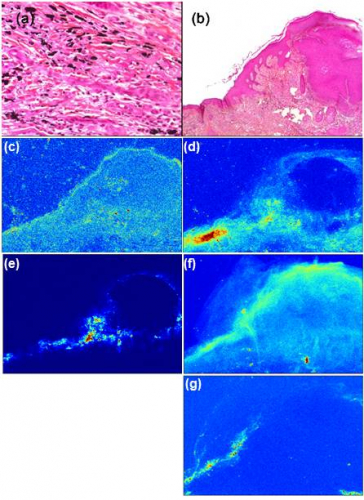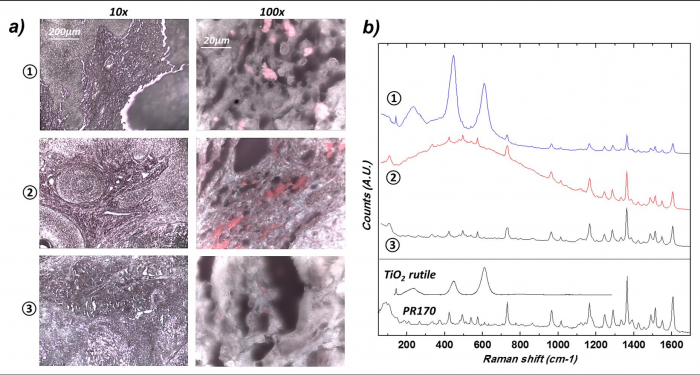Tattoos became a trend during the nineties. Currently, in France 15% of the population are tattooed, including 25% of those under the age of 30. However, this practice involves a risk of skin reaction, which can be linked both to the conditions in which the tattoo is carried out and to the composition of the pigments introduced into the dermis. The development of skin cancer is also a proven, although rare, complication.
In order to determine the nature and location in the skin of the organic and inorganic compounds present in tattoo inks and to study a possible link to the occurrence of cancer, analyses were conducted by researchers from the Rothschild, Tenon and Bichat-Claude Bernard Hospitals (Sorbonne University and Paris Descartes University), the Institute of Physical Chemistry (Paris-Saclay University) and UMR 8235 (Sorbonne University), in collaboration with the DIFFABS beamline at SOLEIL.
Tattooing is an ancestral practice, it was usually carried out with Indian ink or charcoal or tallow-based inks in the form of a permanent decorative and/or symbolic design on the skin. In Polynesia (the Marquesas Islands and New Zealand) tattoos generally signified membership of a high social rank. Etymologically, 'ta' signifies drawing and 'atua' signifies 'spirit, god'.
Tattoos have become a trend since the nineties. Their aesthetic and artistic dimension developed with the use of industrial pigments and their countless colours. Certain tattoos are sometimes considered to be genuine works of art. Currently, 15% of the French population are tattooed, 25% are under 30.
Tattooing consists in piercing the epidermis with thin needles, so as to inject pigments into the dermis to create a design that is meant to last a lifetime. This practice exposes the skin to a risk of reaction to the pigments inserted in this way, a risk that is all the greater as industrial inks contain numerous compounds, including polycyclic aromatic hydrocarbons, azo pigments, metals (titanium-chromium, iron, cobalt, nickel, copper), as well as various ingredients to stabilise the compounds. Some skin cancers are suspected to be amongst the pathologies linked to tattooing, they are a proven yet rare complication. However, their prevalence could increase due to the rise in the number of people getting tattoos.
In order to understand the origin of the occurrence of these tumours, it is necessary to determine the nature of the organic and inorganic compounds present in tattoo inks. For this purpose, various characterization techniques are implemented, including experiments on SOLEIL's DiffAbs beamline.
Fifteen biopsies were analysed, including three from patients with keratoacanthoma type skin cancers, the other cases involved allergic skin reactions to tattoos. In all cases, X-ray microfluorescence analysis determined the presence and distribution of metals such as titanium, iron and zinc. The possibility of conducting measurements at the cellular level made it possible to locate the titanium in the immediate vicinity of the skin tumour, suggesting a probable causal link.

Figure 1: Optical microscopy and XRF correlation of one case of skin cancer: Optical microscopy, showing mainly black ink in the superficial and deep dermis, with little, dispersed, and less visible, pink ink, surrounding the tumoral mass: a) Hematoxylin–eosin–saffron (HES)-stained (x400) b) HES-stained (x25). An X-ray fluorescence map was acquired at 10keV using a 10µm step size and fast acquisition time (80ms). The main elements observed are c) Ca, d) Fe e) Ti f) Zn and g) Cu. The size of the paraffin-embedded tissue block analyzed is 6 x 4.4 mm.
The presence of an organic compound - Pigment Red 170 (PR170) or naphthol red - was identified by Raman spectrometry on biopsies from three cancer patients. This correlation raises the question of the carcinogenicity of this pigment and its role in the development of keratoacanthomas. Used extensively in automotive coatings, the degradation of the substance Pigment Red PR170 can lead to the formation of an aromatic amine with established carcinogenic properties.1,2 However, PR170 is absent from the list of carcinogenic tattoo pigments established by the European Council.

Figure 2: Raman spectroscopy a) Optical micrographs of three cases of skin cancer at two different magnifications (10X and 100X) revealing the presence of micron size red pigment clusters. On patient 1, note the heterogenous and lighter aspect of the red pigment, suggesting the presence of nanoparticles of TiO2. b) Corresponding Raman spectra (excitation wavelength λexc = 785 nm, objective 100X, numerical aperture = 0.9). Spectra are presented as collected (no correction of the luminescence background). Reference spectra are also given as comparison: PR170 dye sample (Kremer) collected at λexc = 785nm and rutile (TiO2) downloaded from the RRUFF database (ID R110109, 780nm).
This work highlights the potential carcinogenic risk posed by tattoo inks and calls for more stringent global regulation of the organic and inorganic compounds present in inks. Future analyses conducted on other cancer biopsies developed on tattoo inks may provide evidence for the possible link between the presence of pigments that can lead to the formation of aromatic amines and the development of skin cancers.
1. Schreiver I, Hutzler C, Andree S, Laux P, Luch A. Identification and hazard prediction of tattoo pigments by means of pyrolysis—gas chromatography/mass spectrometry. Arch Toxicol. 2016; 90: 1639‑1650.
2. Ward E, Carpenter A, Markowitz S, Roberts D, Halperin W. Excess Number of Bladder Cancers in Workers Exposed to Ortho-Toluidine and Aniline. J Natl Cancer Inst. 1991; 83: 501‑506.
